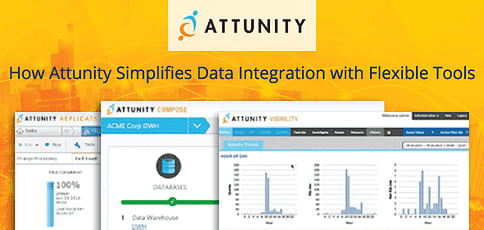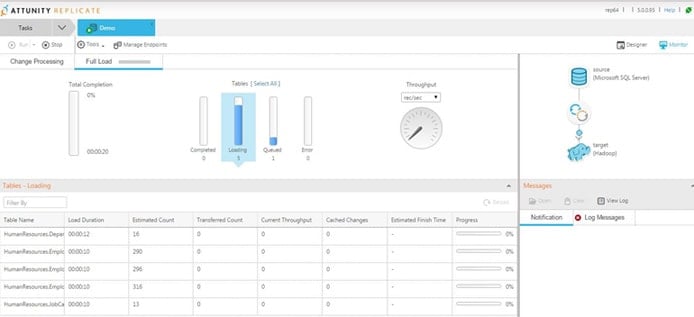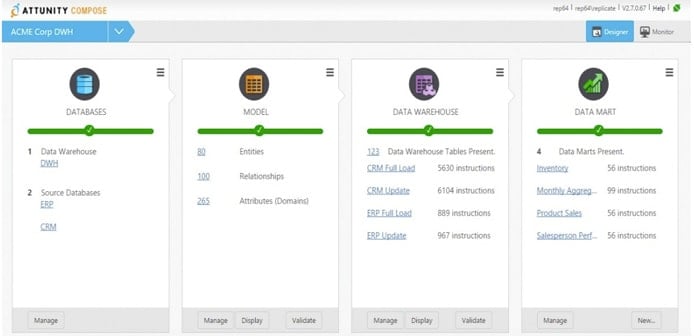
TL; DR: With companies using a growing number of data resources to identify operational efficiencies and lead business decisions, there is less time for manual coding and latency. Attunity, our Developers’ Choice™ award recipient for efficient data integration and management, accelerates data delivery, storage, and availability with their software portfolio. We focus on three signature programs — Replicate, Compose, and Visibility — to show how users can seamlessly and securely ingest data and automate routine data management and warehousing processes.
Swiss Life Group, one of Europe’s leading insurance and wealth management companies, wanted to aggregate customer data across multiple backend systems into a single, searchable index. Previously, each backend system needed to be accessed individually and would present data slightly differently — confusing customers, salespeople, and employees.
By using programs from Attunity, Swiss Life aggregated the data from the mainframe to a central database that served a common search engine. Now, customers can access real-time information about their policies through web, tablet, and mobile applications, and the company is expanding the functionality to other departments, distributors, and service agents.
“Without Attunity, we could not have done the project,” Architecture Director Christian Phan-Trong said in a case study. “It would have been too costly for us in terms of development work. We would have been forced to give up on our real-time data propagation requirement.”
While Attunity customers tend to fall in the Fortune 2,000 ranks, Senior Director of Product Marketing Kevin Petrie said several products, such as CloudBeam, have an active user base of mid-sized companies, as well. “The technology we have certainly works for companies of any size,” he said.
Why Efficient Data Integration is Hard to Accomplish
As the amount and variety of data that businesses need continue to grow, Kevin said the more traditional processes and programs haven’t kept pace.
Designing and building data integration systems or warehouses often require several weeks and ETL (extract, transform, and load) programmers. The time- and resource-intense setup and maintenance can be prohibitive to companies — especially those trying to use the data to boost operational efficiency.
Customers Require Agility, Immediacy, and Flexibility
According to Kevin, prospective customers are typically looking to meet three common needs when implementing a data integration system:
- Ingest and replicate data on demand: Organizations need to gather and move data quickly between systems. “That agility is a big requirement,” he said.
- Real-time streaming: Instant data updates enable companies to immediately seize customer opportunities or operational efficiencies.
- Cross-platform support: The ability to share data across multiple databases and platforms provides a tractable solution devoid of proprietary interface limitations.
Most data loses much of its value to a company after 30 minutes, Kevin said. Retailers, for example, can use sales information to immediately continue the relationship with shoppers after they make a purchase.
“You can make a real-time offer based on social media patterns for that demographic, for instance,” he said. “There are all sorts of things you can find out about in real time to profile that customer and make a next best offer to cross-sell.”
Solutions Challenged by Complexity, Latency, and Inconsistent Support
Change data capture, or CDC, programs identify, capture, and deliver information to a targeted database, warehouse, Hadoop, or the cloud. Attunity and competitors aim to mitigate the following three challenges, according to Kevin:
- Complex manual coding: Traditional methods of copying data involve a lot of time-consuming and complicated ETL programming.
- Latency in transfers: With massive amounts of data to move, inefficient replication programs might slow down the performance of production applications.
- Inconsistent processes: Specific platforms and tools often require particular procedures to move and process data effectively, which may or may not be intuitive.
Attunity considers itself the top independent provider of streaming CDC. Most competitors, including Oracle, offer programs tailored to their related, in-house products. At last count, however, Kevin said Attunity supports 36 data sources and targets.
“They simply can’t have the same level of support for other platforms,” he said. “Our independence gives us the ability to partner closely with Microsoft, Teradata, Hewlett Packard Enterprise, and many others in order to integrate tightly and move data anywhere it needs to be, in real time.”
How Attunity Programs Help Companies Move, Prepare, and Analyze Data
Kevin said Attunity programs help businesses capitalize on analytics with automation and intelligence, realizing Attunity’s mission to empower IT departments to deliver data in larger quantities with speed and efficiency.
“All the things that required a lot of talented, manual, ETL programmers to do are now happening with automation through a drag-and-drop, web-based interface,” he said.
1. Replicate™ Ingests and Streams Data Across Multiple Platforms
Attunity’s flagship product, Replicate, copies data in bulk or real time from production environments and replicates it in an analytics repository such as Hadoop or data warehouses.
Users automate data integration without coding by defining data sources and targets in an intuitive portal and can track the progress in real time.

Replicate moves data quickly and securely across dozens of supported platforms in real time.
“You can move a bulk load of data and then immediately transition to real-time CDC to keep it current,” Kevin said. “We can do that with our very lightweight, rapid, and effective software tool.”
Among the company’s newest offerings, Enterprise Manager provides a central interface for managing and monitoring data ingestion across the customer’s Replicate environment.
“Suddenly, a massive, enterprise-wide data consolidation effort becomes much more feasible,” Kevin said. “It’s not overwhelming in terms of labor because you’ve got this single command center for your operations.”
2. Compose™ Automates Routine Data Warehousing Processes
Once data integration has been streamlined, Attunity Compose can help customers automate the creation, management, and updating of data warehouses.

Compose automates time-consuming processes for storing information in data warehouses.
Building a data warehouse comes with many of the same time and resource demands as replicating it, according to Kevin, who told us about a major insurance company who had budgeted 45 days for ETL programmers to manually set up an environment. By using Compose instead, the timeline shrunk to just two days.
“It can be pretty cumbersome to set something up and update it in time to meet the needs of the business,” Kevin said. “Automating the process can be a big step forward for our organizations, and they can be very ambitious in their data replication and consolidation efforts.”
3. Visibility™ Measures the Impacts of Data for Real-Time Insights
One of the world’s largest automotive companies uses Attunity Replicate to consolidate data from hundreds of sources to address a variety of business needs, including predictive maintenance within their manufacturing process. The carmaker can use the data to determine which procedures to improve, predict what could go wrong, and address the issue before it escalates.
The same approach can be applied to companies’ data resources with Attunity Visibility, which provides information about how data is being used and what it means for the infrastructure in terms of performance, data placement, cost, and compliance.

Visibility provides analytics for your analytics — optimizing how your infrastructure performs and data is stored.
“It’s giving you analytics on data so you understand how to manage that data more effectively and more efficiently,” Kevin said. “It’s a tricky operation regardless, but we’ve sought to reduce the complexity and amount of time required to understand what’s happening in your environment.”
Attunity Advantages: Tools Help Companies Stay on Top of Data Trends
As data usage and requirements evolve, so do the features Attunity offers customers, Kevin said. Updates throughout the years have helped customers capitalize on popular technologies such as Hadoop and cloud storage platforms.
“We’re helping large organizations consolidate data from dozens or hundreds or potentially thousands of endpoints into Hadoop data lakes,” Kevin said. “Also, most organizations have some cloud as part of their architecture, and that’s growing. More and more, Replicate is helping customers move some of that data to the cloud.”
No matter the platform, Kevin said Attunity prides itself on providing real-time and simple offerings for complicated Big Data systems.
“We want to make complexity transparent to the user,” he said. “Through close integration and collaboration with all the major platform vendors, and through very careful design of our automated interface, we make sure that complexity is greatly reduced for administrators who need to integrate data.”
HostingAdvice.com is a free online resource that offers valuable content and comparison services to users. To keep this resource 100% free, we receive compensation from many of the offers listed on the site. Along with key review factors, this compensation may impact how and where products appear across the site (including, for example, the order in which they appear). HostingAdvice.com does not include the entire universe of available offers. Editorial opinions expressed on the site are strictly our own and are not provided, endorsed, or approved by advertisers.
Our site is committed to publishing independent, accurate content guided by strict editorial guidelines. Before articles and reviews are published on our site, they undergo a thorough review process performed by a team of independent editors and subject-matter experts to ensure the content’s accuracy, timeliness, and impartiality. Our editorial team is separate and independent of our site’s advertisers, and the opinions they express on our site are their own. To read more about our team members and their editorial backgrounds, please visit our site’s About page.

